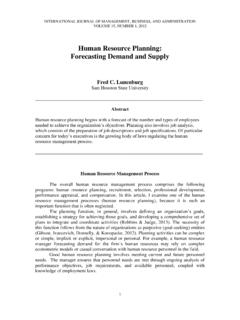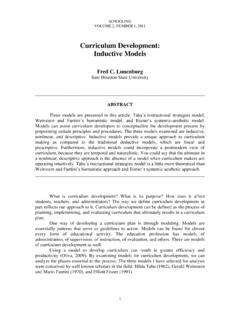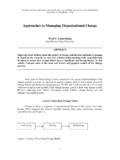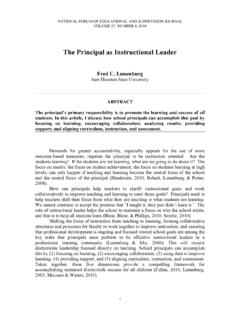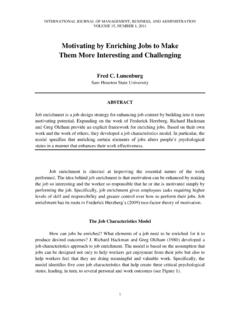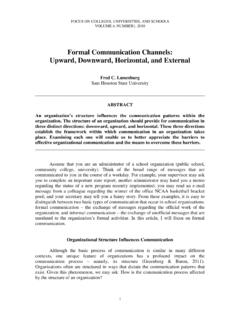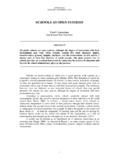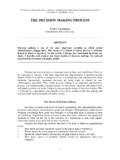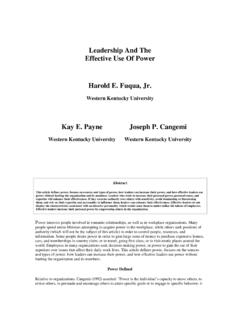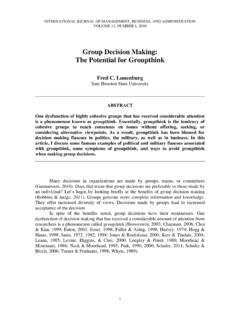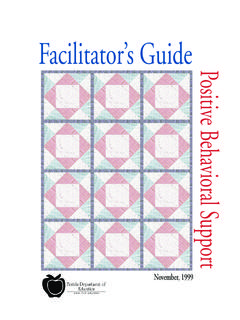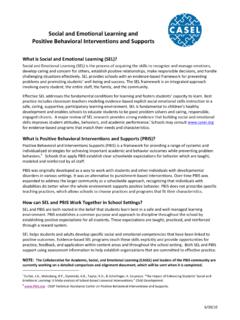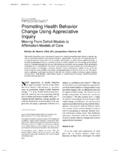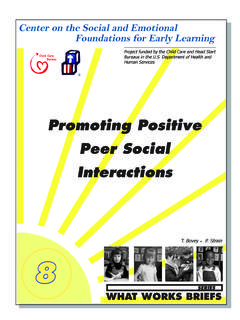Transcription of The Crisis Management Plan: Promoting School …
1 NATIONAL FORUM OF EDUCATIONAL ADMINISTRATION AND SUPERVISION JOURNAL. VOLUME 27, NUMBER 4, 2010. The Crisis Management plan : Promoting School Safety Fred C. Lunenburg Sam Houston State University _____. ABSTRACT. A serious problem facing School administrators today is the increasing level of lethal violence in schools. It is essential for School administrators to anticipate and be prepared for every imaginable Crisis . Therefore, all schools need to have a comprehensive Crisis Management plan . In this article, I discuss the nine steps contained in an ideal Crisis Management plan . _____. One of the most serious problems that School administrators face today is the increasing level of lethal violence in schools. The Columbine High School massacre is just one example (Marsico, 2011).
2 It is essential for School administrators to be prepared for such incidents. Schools need to have a comprehensive Crisis Management plan in order to prepare for every imaginable Crisis (Philpott, 2010). By adhering to the following steps, School administrators can ensure to the greatest degree possible that their schools are safe for students and staff alike (Fox, 2011; Hauserman, 2011; Lindeen, 2012;. Reeves, 2010). Form a School -wide Crisis Management Team The team should be made up of School staff and parents, as well as representatives from social service and mental health agencies, the religious community, recreational organizations, and law enforcement. The charge of the Crisis Management team is to develop and evaluate a comprehensive plan for School safety.
3 Conduct an Ongoing, School -wide Safety Audit A firm knowledge base has emerged, called Crime Prevention Through Environmental Design (CPTED), which examines the design and use of School spaces according to how well they enhance School safety (Hauserman, 2011). A CPTED. evaluation prescribes changes in the design of the School building, in patterns of building use, and in supervision processes to reduce the likelihood of School crime and violence. 1. NATIONAL FORUM OF EDUCATIONAL ADMINISTRATION AND SUPERVISION JOURNAL. 2_____. Items addressed in a CPTED analysis would include the design and location of bathrooms; the height of windows; how entrances and exits to the School are monitored and managed; the use of lighting, natural surveillance capabilities, and obstructions thereof; where locker bays are located and how they are managed; identification of low- traffic areas requiring an increased adult presence; identification of School sites that tend to be inhabited inappropriately by certain groups of students; scheduling procedures that result in large groups of students coming in contact with each other in crowded spaces.
4 How students and other adults who belong in the School are recognized and identified;. and procedures that allow students to communicate anonymously their concerns about other students or situations. Develop Policies and Procedures for Various Emergencies Specific policies and procedures must be developed to address a wide range of potential problems at the district, School , and classroom levels. These could include a violence-prevention policy, a zero-tolerance policy for weapons and drugs, a dress code, and an intruder policy. It may be helpful if the principal divides policies and procedures into categories like the following (Reeves, 2010): 1. The people Crisis category could include medical emergencies, intruders, drive-by shootings, student runaways or abductions, deaths of students or staff members, and bomb threats.
5 2. The natural disaster category could include fires, tornados, earthquakes, other severe weather, or floods. 3. The physical plant category could include policies that address power outages, nonworking phone lines, gas leaks, hazardous materials, or explosions. Conduct Safety Drills Every aspect of the Crisis Management plan should have at least two people responsible for coordinating each task. Staff members should be assigned to respond to emergency teams, parents, and the press. Each School should carefully consider its physical plant and analyze where students should be directed to go from wherever they are in the School . Upon hearing a predetermined signal or tone, teachers should lock down classrooms (Fuentes, 2012; Lassiter, 2010).
6 Every room should have two methods for communicating with the office ( , a two-way public announcement system and a phone, cell phone, or walkie-talkie). Develop a School -wide Discipline plan School discipline should be consistent, predictable, and perceived as fair by students in the School (Thompson, 2011). It is essential that every Crisis Management plan include a carefully developed School -wide discipline plan that has input from teachers, students, parents, administrators, and other adults in the School (Bear, 2011). FRED C. LUNENBURG. _____3. The plan should be posted throughout the School with clearly stated rules that govern classroom, cafeteria, playground, gym, and hallway behavior. Provide a Means for Students to Communicate Information to Staff A recent report notes that in several instances of School violence or student suicide, some students knew in advance of the activity but did not tell anyone (Juhnke, 2011).
7 It is essential in such situations that children have a way to communicate their concerns or fears to the staff in a way that maintains confidentiality, respect, and safety. Teach Students Alternatives to Violence In any program aimed at averting student violence, it is first necessary to focus attention on students' individual needs and problems (Gallant, 2011). School staff should address such topics as self-esteem, conflict resolution, impulse control, consequences of gang membership, and stress Management (Yell, 2009). Schools also need to foster a sense of belonging among students. One reason why students join gangs is that these groups meet their need for belonging (Soliz). After- School extracurricular activities and clubs also may help reduce violence (Barbieri, 2009; Jones, 2011).
8 Evaluate Administrative Practices of the School How a School is operated can have a strong impact on its relative safety. Academically effective schools, for example, tend to be safer schools (Bulach, Lunenburg, & Potter, 2008). Schools that provide a positive, inclusive climate tend to have less conflict and fewer instances of aggressive, bullying behavior (Espelage, 2011). Schools that have the number of students for which they were designed tend to have fewer behavioral incidents and problems (Reeves, 2010). Safer schools tend to have clear behavioral and performance expectations for everyone (Drolet, 2011; Locke &. Latham, 2012). Use Resources to Identify Students At-Risk for Violent Behavior School administrators can use an excellent resource for identifying troubled youth and responding to their needs.
9 It is called the Early Warning/Timely Response Guide for making schools safer and violence free. This guide was jointly developed by the Attorney General's Office and the Department of Education. It contains comprehensive guidelines and recommendations for the early profiling of troubled youth and the role that schools, teachers, parents, communities, and peers can play in responding to their problems and meeting their needs. It is a valuable tool for addressing the current Crisis of School safety. The guide is a public-domain publication. It costs nothing. The guide can be downloaded from the Internet at the following URL: Table 1 provides a sample checklist that School administrators can use to identify violence-prone students.
10 NATIONAL FORUM OF EDUCATIONAL ADMINISTRATION AND SUPERVISION JOURNAL. 4_____. Table 1. Checklist for Identifying Students at Risk for Violent Behavior Children and adolescents at risk may: express self-destructive or homicidal ideation have a history of self destructive behavior articulate specific plans to harm self or others engage in bullying other children have difficulty with impulse control evidence significant changes in behavior engage in substance abuse become involved with gangs evidence a preoccupation with fighting have a history of antisocial behavior evidence a low tolerance for frustration externalize blame for their difficulties evidence a preoccupation with guns and weapons have engaged in fire setting evidence persistent bed wetting appear to be, or acknowledge, feeling depressed talk about not being around.
